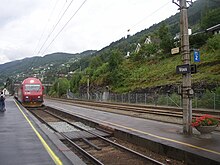Voss Line
| Voss Line | |
|---|---|

Longhaul NSB El 18 locomotive at Voss Station
|
|
| Overview | |
| Native name | Vossebanen |
| Type | Railway |
| System | Norwegian railway |
| Status | Merged with the Bergen Line |
| Termini |
Hønefoss Bergen |
| Stations | 39 |
| Operation | |
| Opened | 11 July 1883 |
| Owner | Norwegian State Railways |
| Operator(s) | Norwegian State Railways |
| Character | Passenger and freight |
| Technical | |
| Line length | 106.7 kilometres (66.3 mi) |
| Number of tracks | Single |
| Track gauge | 1,435 mm (4 ft 8 1⁄2 in) standard gauge |
| Old gauge | 1,067 mm (3 ft 6 in) |
| Electrification | 15 kV 16 2⁄3 Hz AC |
The Voss Line (Norwegian: Vossebanen) is a railway line from Bergen to Voss in Hordaland, Norway. It opened on 11 July 1883 and was extended to Oslo as the Bergen Line on 27 November 1909. It was built as 1,067 mm (3 ft 6 in) narrow gauge, but converted to 1,435 mm (4 ft 8 1⁄2 in) standard gauge with the connection with the Bergen Line. It was electrified in 1954, and shortened by the Ulriken Tunnel in 1963.
In addition to carrying long-haul passenger and freight trains on the Bergen Line, it is the main part of Bergen Commuter Rail. The Old Voss Line, the section from Arna to Bergen, has become a heritage railway.
The first documented idea of building a railway between Norway's two largest cities was launched by Voss forest supervisor Hans Gløersen on 24 August 1871 in the Bergensposten newspaper. He suggested building the railway via Voss and Hallingdal to connect with the Krøderen Line. Back in 1866 he had launched the idea of the Jæren Line. Within days of the launch of the Bergen Line the city council had garnered support. In 1872 the railway director Carl Abraham Pihl and two engineers went on a survey tour to look at the suggested line. At the time it was common that proposals for railways came from local initiatives, and that local municipalities and private investors would then pay about 20% of the investments, the state covering the rest, mostly through foreign debt.
...
Wikipedia
